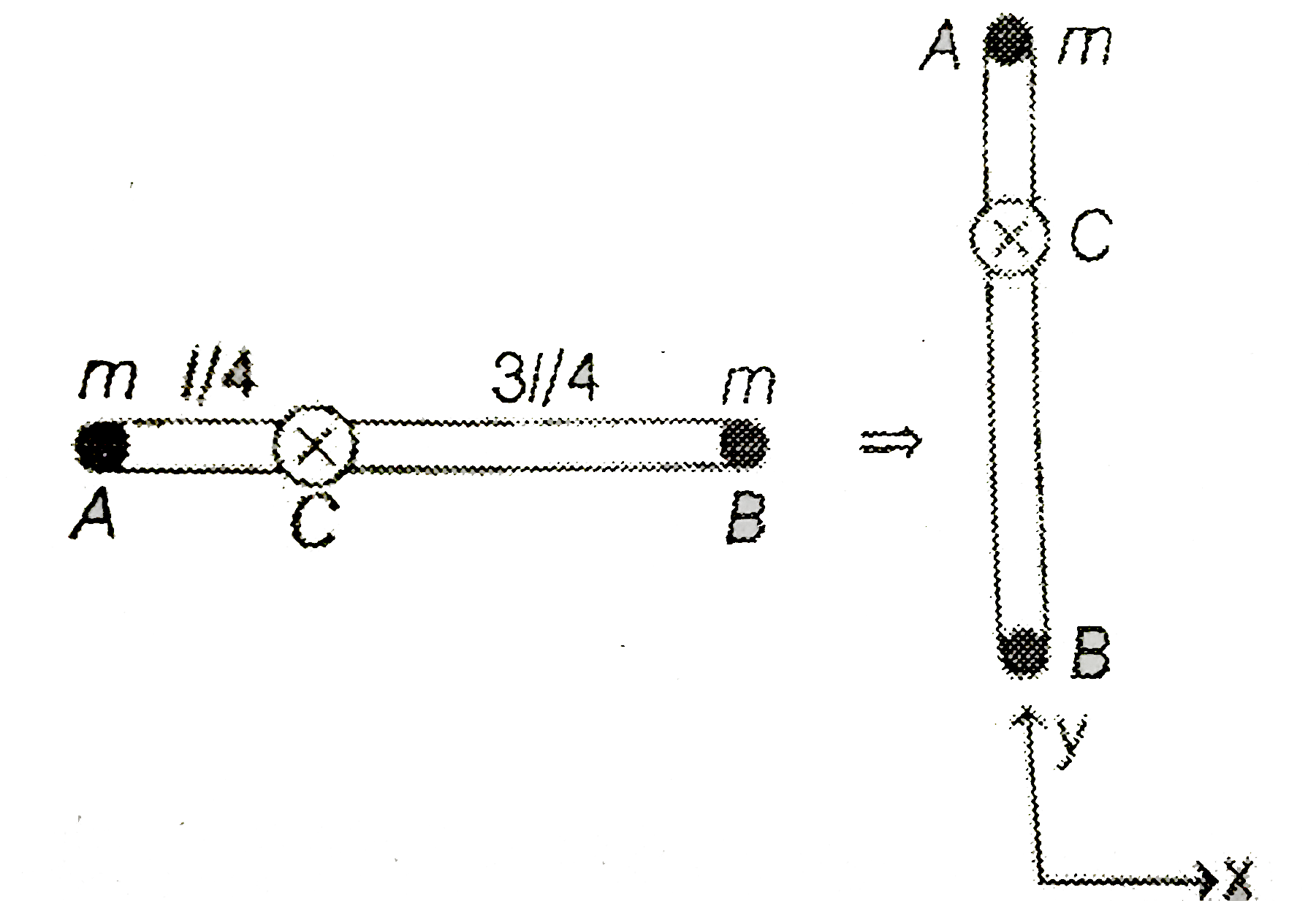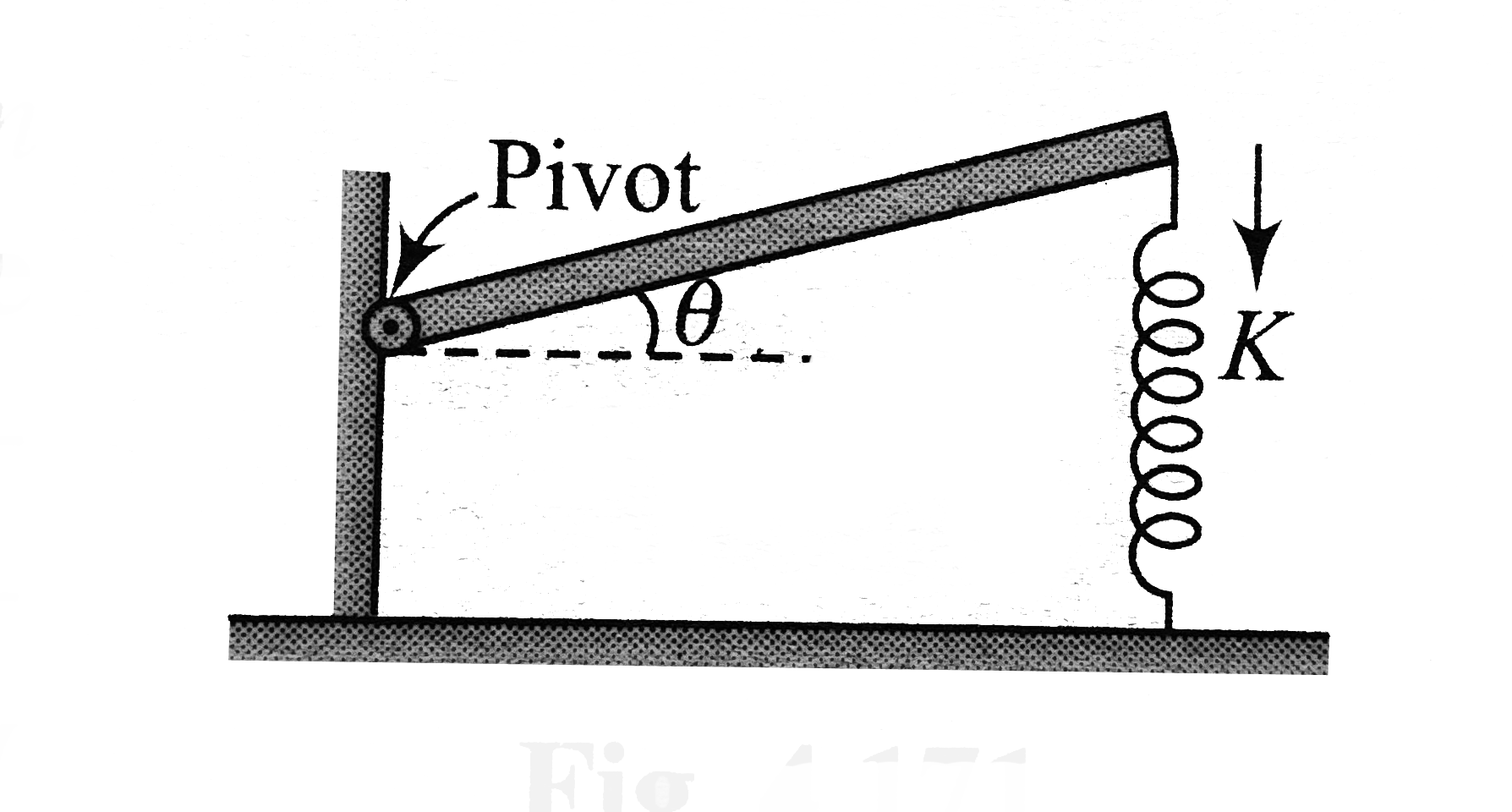A rod of length L is hinged from one end. It is brought to a horizontal position and released. The angular velocity of the rod, When it is in verticle position is
√2gL
√3gL
√g2L
√gL
The correct Answer is:B
To find the angular velocity of a rod of length L when it is in a vertical position after being released from a horizontal position, we can use the principle of conservation of energy. Here’s a step-by-step solution:
Step 1: Understand the System
The rod is hinged at one end and initially held in a horizontal position. When released, it will fall under the influence of gravity and rotate about the hinge.
Step 2: Identify the Initial and Final States
- Initial State: The rod is horizontal. The center of mass of the rod is at a height of L2 above the lowest point (the vertical position).
- Final State: The rod is in a vertical position. At this point, all the potential energy has been converted into rotational kinetic energy.
Step 3: Calculate Initial Potential Energy
The potential energy U of the rod when it is horizontal can be calculated as:
Ui=mgh
where h is the height of the center of mass from the lowest point. Since the center of mass is at L2 when the rod is horizontal:
Ui=mg(L2)
Step 4: Calculate Final Kinetic Energy
When the rod is in the vertical position, all the potential energy has been converted into rotational kinetic energy K:
Kf=12Iω2
where I is the moment of inertia of the rod about the hinge. For a rod of length L hinged at one end, the moment of inertia is:
I=13mL2
Step 5: Apply Conservation of Energy
According to the conservation of energy:
Ui=Kf
Substituting the expressions for potential energy and kinetic energy:
mg(L2)=12(13mL2)ω2
Step 6: Simplify the Equation
Cancel m from both sides (assuming m≠0):
g(L2)=16L2ω2
Multiply both sides by 6:
3gL=L2ω2
Step 7: Solve for Angular Velocity ω
Divide both sides by L2:
ω2=3gL
Taking the square root gives:
ω=√3gL
Final Answer
The angular velocity of the rod when it is in the vertical position is:
ω=√3gL
The rod is hinged at one end and initially held in a horizontal position. When released, it will fall under the influence of gravity and rotate about the hinge.
- Initial State: The rod is horizontal. The center of mass of the rod is at a height of L2 above the lowest point (the vertical position).
- Final State: The rod is in a vertical position. At this point, all the potential energy has been converted into rotational kinetic energy.
The potential energy U of the rod when it is horizontal can be calculated as:
Ui=mgh
where h is the height of the center of mass from the lowest point. Since the center of mass is at L2 when the rod is horizontal:
Ui=mg(L2)
When the rod is in the vertical position, all the potential energy has been converted into rotational kinetic energy K:
Kf=12Iω2
where I is the moment of inertia of the rod about the hinge. For a rod of length L hinged at one end, the moment of inertia is:
I=13mL2
According to the conservation of energy:
Ui=Kf
Substituting the expressions for potential energy and kinetic energy:
mg(L2)=12(13mL2)ω2
Cancel m from both sides (assuming m≠0):
g(L2)=16L2ω2
Multiply both sides by 6:
3gL=L2ω2
Divide both sides by L2:
ω2=3gL
Taking the square root gives:
ω=√3gL
The angular velocity of the rod when it is in the vertical position is:
ω=√3gL
Topper's Solved these Questions
- MOCK TESTBOOK - A2ZCHAPTER - MOCK TESTEXERCISE - General Kinematics
30 Videos
- MOCK TESTBOOK - A2ZCHAPTER - MOCK TESTEXERCISE - Motion With Constant Acceleration
15 Videos
- KINETIC THEORY OF GASES AND THERMODYNAMICSBOOK - A2ZCHAPTER - KINETIC THEORY OF GASES AND THERMODYNAMICSEXERCISE - Chapter Test
29 Videos
- MOTION IN TWO DIMENSIONBOOK - A2ZCHAPTER - MOTION IN TWO DIMENSIONEXERCISE - Chapter Test
29 Videos
Similar Questions
A rod of length L is hinged from one end. It is brought to horizontal position and released. The angular velocity of the rod when it is in vertical position. Is
View SolutionA rod of length L is hinged from one end. It is brought to the horizontal position and released. The angular velocity of the rod when it is in the vertical position is √Kg/L. Then find the value of K.
View Solution
Knowledge Check
A rod of length L is hinged from one end. It is brought to a horizontal position and released. The angular velocity of the rod, when it is in vertical position, is
A√2gLB√3gLC√g2LD√gLA uniform thin rod of length l and mass m is hinged at a distance l/4 from one of the end and released from horizontal position as shown in Fig. The angular velocity of the rod as it passes the vertical position is
 A2√5g7lB2√6g7lC√3g7lD2√gl
A2√5g7lB2√6g7lC√3g7lD2√glIn the above problem, if the rod is released from horizontal position, the angular velocity of the rod as it passes the vertical position is (l=length fo rod)
A√12g5lB√2g3lC√3glD√3g7l
Consider a uniform rod of mass M and length L is hinged at one end as shown. Initially the rod is vertical, it is slightly pushed and released. Find the angular velocity of rod and liner velocity of its one end when the rod becomes horizontal. Also calculate angular velocity of rod when it has rotated by an angle θ(θ<90∘).
View SolutionA rigid rod of mass m & length l is pivoted at one of its ends. If it is released from its horizontal position, find the speed of the centre of mass of the rod when it becomes vertical.
View SolutionA thin bar of mass M and length L is free to rotate about a fixed horizontal axis through a point at its end. The bar is brought to a horizontal position and then released. The axis is perpendicular to the rod. The angular velocity when it reaches the lowest point is
View SolutionTwo particles each of mass m are attached at end points of a massless rod AB of length l. Rod is hinged at point C as shown. Rod is released from rest from horizontal position. At the instant when rod reaches its vertical position as shown, which of the following is / are correct:

View Solution
A horizontal rod of mass m and length L is pivoted at one end The rod's other end is supported by a spring of force constant k. The rod is displaced by a small angle θ from its horizontal equilibrium position and released. The angular frequency of the subsequent simple harmonic motion is
View Solution
